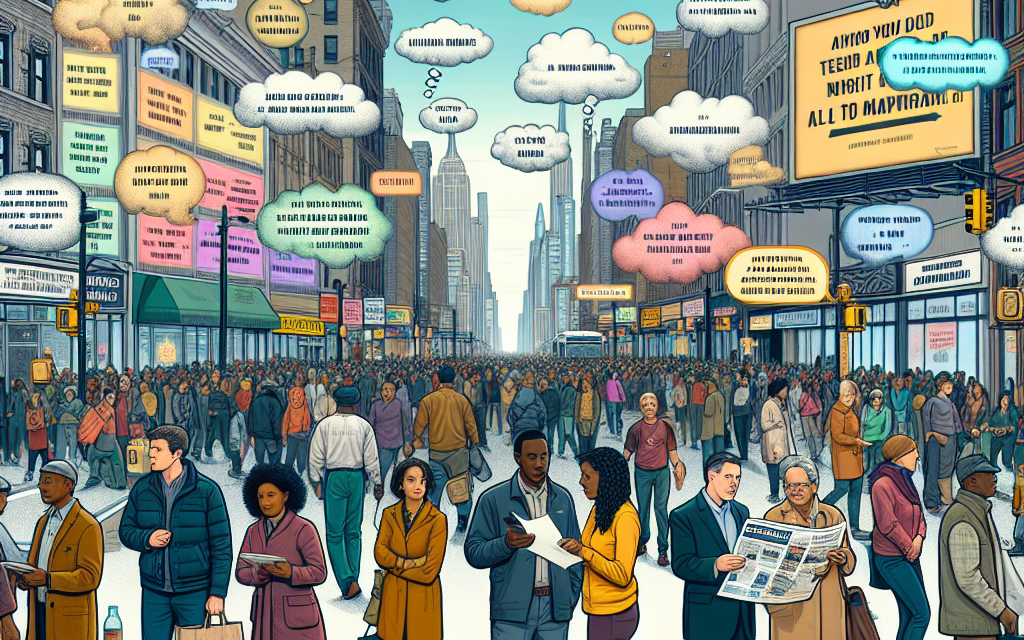“Street Insights Recap: Empowering Communities, Inspiring Change.”
Introduction
Street Insights Recap: A Call to Action serves as a pivotal summary of key findings and discussions from recent urban studies and community engagement initiatives. This report highlights the pressing issues faced by urban neighborhoods, emphasizing the need for collaborative efforts among stakeholders to address challenges such as housing, transportation, and public safety. By synthesizing insights from community members, experts, and policymakers, the recap aims to inspire actionable strategies that foster sustainable development and enhance the quality of life in our cities. It calls on individuals and organizations to unite in their efforts to create vibrant, inclusive, and resilient urban environments.
Street Insights: Understanding Community Needs
In the ever-evolving landscape of urban development, understanding community needs has emerged as a pivotal aspect of fostering sustainable growth and enhancing the quality of life for residents. Street Insights serves as a vital platform that bridges the gap between community voices and decision-makers, facilitating a dialogue that is essential for informed urban planning. By engaging with local residents, stakeholders, and experts, Street Insights aims to gather comprehensive data that reflects the diverse perspectives and requirements of the community.
The importance of this initiative cannot be overstated, as it provides a framework for identifying pressing issues that affect daily life in urban settings. For instance, through surveys, focus groups, and public forums, community members can articulate their concerns regarding transportation, safety, public spaces, and access to essential services. This grassroots approach not only empowers residents but also ensures that their insights are integrated into the planning process, thereby fostering a sense of ownership and accountability among stakeholders.
Moreover, the data collected through Street Insights is instrumental in shaping policies that are responsive to the actual needs of the community. By analyzing trends and patterns in the feedback received, urban planners and local governments can prioritize initiatives that address the most critical challenges faced by residents. For example, if a significant number of community members express concerns about inadequate public transportation options, this information can prompt local authorities to explore solutions such as expanding bus routes or improving infrastructure for cyclists and pedestrians. Consequently, the initiative not only highlights existing issues but also catalyzes action towards meaningful change.
In addition to addressing immediate concerns, Street Insights also plays a crucial role in fostering long-term community resilience. By encouraging ongoing dialogue and collaboration among residents, local organizations, and government entities, the initiative cultivates a culture of engagement that is essential for navigating future challenges. This proactive approach enables communities to adapt to changing circumstances, whether they arise from economic shifts, demographic changes, or environmental factors. As such, the insights gathered through this initiative serve as a foundation for building a more resilient urban environment that can withstand the test of time.
Furthermore, the collaborative nature of Street Insights underscores the importance of inclusivity in urban planning. By actively seeking input from diverse demographic groups, including marginalized communities, the initiative ensures that all voices are heard and considered in the decision-making process. This commitment to inclusivity not only enriches the data collected but also fosters a sense of belonging among residents, reinforcing the idea that everyone has a stake in the future of their community.
As we reflect on the insights gained through this initiative, it becomes clear that the call to action is not merely about addressing current needs but also about envisioning a future that aligns with the aspirations of the community. It is imperative for all stakeholders—residents, local leaders, and policymakers—to engage actively in this ongoing dialogue. By doing so, they can collectively shape a vibrant urban landscape that reflects the values and priorities of its inhabitants. Ultimately, the success of Street Insights hinges on the commitment of the community to participate in this vital process, ensuring that their needs are not only acknowledged but also prioritized in the pursuit of sustainable urban development.
The Importance of Local Engagement in Urban Planning
In the realm of urban planning, the significance of local engagement cannot be overstated. As cities evolve and face new challenges, the involvement of community members in the planning process becomes increasingly vital. Local engagement not only fosters a sense of ownership among residents but also ensures that the diverse needs and aspirations of the community are adequately represented. This participatory approach is essential for creating urban environments that are not only functional but also vibrant and inclusive.
To begin with, local engagement serves as a bridge between planners and the community, facilitating a two-way dialogue that enriches the planning process. When residents are actively involved, they bring unique insights and perspectives that professionals may overlook. For instance, individuals who live in a neighborhood can provide firsthand accounts of traffic patterns, safety concerns, and the social dynamics that shape their daily lives. By incorporating these insights, urban planners can develop solutions that are more attuned to the realities of the community, ultimately leading to more effective and sustainable outcomes.
Moreover, engaging local residents in the planning process cultivates trust and transparency. When community members feel that their voices are heard and valued, they are more likely to support proposed initiatives and policies. This trust is crucial, especially in urban areas where skepticism towards government actions can be prevalent. By fostering an environment of collaboration, planners can mitigate resistance and build a coalition of stakeholders who are invested in the success of urban projects. This collaborative spirit not only enhances the quality of planning but also strengthens community ties, creating a more cohesive social fabric.
In addition to fostering trust, local engagement can also lead to innovative solutions to urban challenges. When diverse groups come together to discuss their visions for the future, they often generate creative ideas that may not have emerged in a more traditional planning setting. For example, community workshops and forums can serve as incubators for brainstorming, allowing residents to propose unique approaches to issues such as affordable housing, public transportation, and green spaces. These grassroots ideas can then be integrated into formal planning processes, resulting in more holistic and responsive urban development.
Furthermore, the importance of local engagement extends beyond the immediate planning phase. It lays the groundwork for ongoing community involvement in the implementation and maintenance of urban projects. When residents are engaged from the outset, they are more likely to take an active role in ensuring that initiatives are carried out effectively. This sustained involvement can lead to better stewardship of public spaces and resources, as community members feel a sense of responsibility for their environment. Consequently, this ongoing engagement can enhance the resilience of urban areas, enabling them to adapt to changing circumstances and challenges.
In conclusion, the importance of local engagement in urban planning is multifaceted and profound. It not only enriches the planning process with valuable insights but also fosters trust, encourages innovation, and promotes sustained community involvement. As cities continue to grow and evolve, it is imperative that urban planners prioritize local engagement as a fundamental component of their work. By doing so, they can create urban environments that truly reflect the needs and aspirations of the communities they serve, ultimately leading to more vibrant, inclusive, and sustainable cities. The call to action is clear: we must embrace local engagement as an essential pillar of effective urban planning.
Analyzing Data Trends from Recent Street Insights
In recent months, the analysis of data trends from Street Insights has revealed significant patterns that warrant attention and action. As urban environments continue to evolve, understanding these trends becomes crucial for stakeholders, including city planners, policymakers, and community organizations. The data collected from various urban areas provides a comprehensive overview of the challenges and opportunities that cities face today. By examining these insights, we can identify key areas that require immediate intervention and strategic planning.
One of the most striking trends observed is the increasing prevalence of pedestrian activity in urban centers. This shift towards walking as a primary mode of transportation highlights a growing public interest in sustainable practices and healthier lifestyles. As cities become more congested, residents are seeking alternatives to vehicular travel, which not only reduces traffic but also contributes to lower emissions. Consequently, this trend underscores the necessity for urban planners to prioritize pedestrian-friendly infrastructure, such as wider sidewalks, improved crosswalks, and dedicated pedestrian zones. By investing in these enhancements, cities can foster a more inviting atmosphere that encourages walking and, in turn, promotes community engagement.
Moreover, the data indicates a notable rise in the use of public transportation systems. This trend reflects a collective desire for efficient and accessible transit options, particularly in densely populated areas. However, while the demand for public transport is increasing, many systems are struggling to keep pace with this growth. Issues such as overcrowding, delays, and inadequate service coverage have been highlighted in the data, suggesting that immediate improvements are necessary. Addressing these challenges not only requires financial investment but also innovative solutions that leverage technology to enhance the user experience. For instance, implementing real-time tracking systems and mobile applications can significantly improve the reliability and convenience of public transport, thereby attracting more users.
In addition to transportation trends, the data also reveals shifts in consumer behavior within urban environments. As more individuals gravitate towards local businesses and community markets, there is a clear opportunity for economic revitalization. This trend emphasizes the importance of supporting small businesses, which are often the backbone of local economies. By fostering an environment that encourages entrepreneurship and innovation, cities can create vibrant neighborhoods that attract both residents and visitors. Initiatives such as grants, tax incentives, and business development programs can play a pivotal role in nurturing these enterprises, ultimately leading to job creation and economic growth.
Furthermore, the analysis highlights the increasing importance of green spaces in urban planning. As cities grapple with issues related to air quality and urban heat islands, the demand for parks and recreational areas has surged. Green spaces not only enhance the aesthetic appeal of urban areas but also provide essential benefits for mental and physical well-being. The data suggests that communities with ample access to parks experience lower levels of stress and higher rates of physical activity. Therefore, integrating more green spaces into urban designs should be a priority for city planners, as it contributes to the overall quality of life for residents.
In conclusion, the insights derived from recent data trends present a compelling case for action. By recognizing the shifts in pedestrian activity, public transportation usage, consumer behavior, and the demand for green spaces, stakeholders can develop targeted strategies that address the evolving needs of urban populations. The time for proactive measures is now, as cities have the opportunity to create more sustainable, inclusive, and vibrant environments for all residents. Embracing these insights will not only enhance urban living but also pave the way for a more resilient future.
Strategies for Effective Community Outreach
In the realm of community outreach, effective strategies are essential for fostering engagement and building lasting relationships between organizations and the communities they serve. To begin with, understanding the unique characteristics and needs of a community is paramount. This involves conducting thorough research, which may include surveys, focus groups, and interviews with community members. By gathering insights directly from the population, organizations can tailor their outreach efforts to address specific concerns and aspirations, thereby ensuring that their initiatives resonate with the community.
Moreover, establishing partnerships with local stakeholders can significantly enhance outreach efforts. Collaborating with schools, businesses, and other community organizations not only amplifies the reach of outreach programs but also fosters a sense of shared responsibility. When multiple entities come together, they can pool resources, share knowledge, and create a more comprehensive approach to addressing community needs. This collaborative spirit not only strengthens the initiatives but also builds trust among community members, who are more likely to engage with programs that reflect a collective effort.
In addition to collaboration, utilizing various communication channels is crucial for effective outreach. Traditional methods such as flyers and community bulletin boards remain valuable, but digital platforms have become increasingly important in reaching diverse audiences. Social media, email newsletters, and community websites can serve as powerful tools for disseminating information and engaging with residents. By employing a multi-channel approach, organizations can ensure that their messages reach a broader audience, accommodating different preferences for information consumption.
Furthermore, it is essential to create inclusive outreach strategies that consider the diverse demographics within a community. This includes being mindful of language barriers, cultural differences, and varying levels of access to technology. Providing materials in multiple languages and ensuring that events are accessible to individuals with disabilities are just a few ways to promote inclusivity. By actively seeking to engage underrepresented groups, organizations can foster a sense of belonging and ensure that all voices are heard in the decision-making process.
Another critical aspect of effective community outreach is the importance of feedback. Establishing mechanisms for community members to provide input on outreach initiatives not only empowers them but also allows organizations to refine their strategies. Regularly soliciting feedback through surveys or community meetings can help identify areas for improvement and ensure that outreach efforts remain relevant and impactful. This iterative process of engagement fosters a culture of transparency and accountability, which is vital for building trust within the community.
Moreover, it is essential to celebrate successes and share stories of impact. Highlighting positive outcomes from outreach initiatives can inspire further participation and demonstrate the tangible benefits of community engagement. By showcasing testimonials and case studies, organizations can illustrate the difference their efforts are making, thereby motivating others to get involved.
In conclusion, effective community outreach requires a multifaceted approach that prioritizes understanding, collaboration, inclusivity, feedback, and celebration of successes. By implementing these strategies, organizations can create meaningful connections with community members, ultimately leading to more successful and sustainable initiatives. As we reflect on the insights gained from recent discussions, it is clear that a call to action is necessary. Engaging with communities in a thoughtful and strategic manner not only enhances outreach efforts but also contributes to the overall well-being and resilience of the community.
The Role of Technology in Gathering Street Insights
In the contemporary landscape of urban development and community engagement, technology plays a pivotal role in gathering street insights that inform decision-making processes. As cities evolve and face multifaceted challenges, the integration of technological tools has become essential for understanding the needs and preferences of residents. This integration not only enhances the quality of data collected but also fosters a more inclusive approach to urban planning.
One of the most significant advancements in this realm is the proliferation of mobile applications and platforms designed to facilitate real-time feedback from citizens. These tools empower individuals to share their experiences and observations regarding public spaces, transportation systems, and local amenities. By harnessing the power of smartphones, municipalities can gather a wealth of information that reflects the diverse perspectives of their constituents. This immediacy of data collection allows for a more dynamic understanding of urban environments, enabling city planners to respond swiftly to emerging issues.
Moreover, social media platforms have emerged as vital channels for gathering street insights. Residents often use these platforms to voice their opinions, share experiences, and highlight concerns related to their neighborhoods. By monitoring social media conversations, city officials can gain valuable insights into public sentiment and identify areas that require attention. This approach not only enhances the responsiveness of local governments but also fosters a sense of community engagement, as residents feel their voices are being heard and valued.
In addition to mobile applications and social media, geographic information systems (GIS) have revolutionized the way urban planners visualize and analyze data. GIS technology allows for the mapping of various urban phenomena, such as traffic patterns, pedestrian flows, and environmental factors. By overlaying different data sets, planners can identify correlations and trends that may not be immediately apparent. This spatial analysis is crucial for making informed decisions that enhance the livability of urban areas. Furthermore, the ability to visualize data in a geographic context enables stakeholders to communicate findings more effectively, fostering collaboration among various entities involved in urban development.
As we delve deeper into the role of technology in gathering street insights, it is essential to acknowledge the importance of data privacy and ethical considerations. With the increasing reliance on digital tools, concerns regarding the collection and use of personal information have come to the forefront. It is imperative for municipalities to establish transparent policies that protect citizens’ privacy while still allowing for the collection of meaningful data. By prioritizing ethical practices, cities can build trust with their residents, encouraging greater participation in the data-gathering process.
Furthermore, the integration of artificial intelligence (AI) and machine learning into data analysis presents exciting opportunities for enhancing street insights. These technologies can process vast amounts of data quickly, identifying patterns and trends that may elude human analysts. By leveraging AI, urban planners can make more accurate predictions about future needs and challenges, ultimately leading to more effective and sustainable urban development strategies.
In conclusion, the role of technology in gathering street insights is multifaceted and continually evolving. From mobile applications and social media to GIS and AI, these tools provide invaluable resources for understanding urban dynamics. As cities strive to become more responsive and inclusive, it is crucial to embrace these technological advancements while remaining vigilant about ethical considerations. By doing so, urban planners can foster a collaborative environment that not only addresses the immediate needs of residents but also paves the way for a more sustainable and equitable future.
Case Studies: Successful Community Action Initiatives
In recent years, numerous communities have demonstrated the power of collective action through successful initiatives that address local challenges and foster a sense of unity. These case studies serve as compelling examples of how grassroots movements can lead to meaningful change, inspiring others to take similar steps in their own neighborhoods. One notable instance is the revitalization of a neglected urban park in a mid-sized city, where residents banded together to transform an underutilized space into a vibrant community hub. Initially, the park was plagued by litter, overgrown vegetation, and a lack of recreational facilities. However, through a series of community meetings, residents identified their shared vision for the park’s future. They organized clean-up days, secured funding through local grants, and collaborated with landscape architects to design a space that would cater to all age groups. As a result, the park not only became a safe and inviting area for families but also hosted events that strengthened community ties, such as movie nights and farmers’ markets.
Another exemplary initiative can be found in a small town that faced significant food insecurity. Recognizing the need for accessible and nutritious food options, a group of concerned citizens established a community garden. This project began with a simple idea: to utilize vacant lots for growing fresh produce. The initiative quickly gained momentum as volunteers from diverse backgrounds came together to cultivate the land. They not only grew vegetables but also created educational programs that taught sustainable gardening practices and nutrition. The garden became a source of fresh food for local families, while also fostering a sense of ownership and pride among participants. This case illustrates how community-driven solutions can effectively address pressing social issues while simultaneously promoting environmental stewardship.
In another instance, a neighborhood in a large metropolitan area faced challenges related to crime and safety. Residents, feeling disheartened by the rising incidents of violence, decided to take action by forming a neighborhood watch program. This initiative began with a series of meetings where community members discussed their concerns and brainstormed potential solutions. They established a communication network that allowed residents to report suspicious activities and share safety tips. Additionally, they collaborated with local law enforcement to organize safety workshops and community patrols. Over time, the program not only reduced crime rates but also fostered a renewed sense of trust and cooperation among residents. This case highlights the importance of proactive engagement in creating safer environments and demonstrates how collective vigilance can lead to tangible improvements in community safety.
Moreover, the success of these initiatives underscores the significance of collaboration among various stakeholders, including local governments, non-profit organizations, and businesses. By leveraging resources and expertise, communities can amplify their impact and create sustainable change. For instance, partnerships with local schools can enhance educational initiatives, while collaborations with businesses can provide financial support and resources for community projects. As these case studies illustrate, successful community action initiatives are often characterized by a shared vision, active participation, and a commitment to inclusivity.
In conclusion, the examples of community action initiatives presented here serve as a powerful reminder of the potential for collective efforts to effect positive change. They highlight the importance of grassroots movements in addressing local challenges and fostering a sense of belonging. As communities continue to face various social, economic, and environmental issues, these case studies provide valuable insights and inspiration for others to take action. By coming together, residents can create lasting impacts that enhance their neighborhoods and improve the quality of life for all.
Future Directions for Street Insights and Community Involvement
As we reflect on the recent developments within the Street Insights initiative, it becomes increasingly clear that the future of this program hinges on robust community involvement and strategic direction. The insights gathered from various stakeholders have illuminated the path forward, emphasizing the need for a collaborative approach that not only addresses immediate concerns but also fosters long-term sustainability. In this context, it is essential to consider how community engagement can be enhanced to ensure that the voices of residents are not only heard but actively shape the outcomes of the initiative.
One of the primary future directions for Street Insights is the establishment of more inclusive platforms for community dialogue. By creating spaces where residents can share their experiences and perspectives, we can cultivate a deeper understanding of the challenges they face. This engagement can take many forms, including town hall meetings, focus groups, and online forums, each designed to facilitate open communication. Such initiatives will not only empower community members but also provide valuable data that can inform decision-making processes. As we move forward, it is crucial to prioritize these interactions, ensuring that they are accessible and representative of the diverse voices within the community.
Moreover, the integration of technology into the Street Insights framework presents an opportunity to enhance community involvement. Digital tools can facilitate real-time feedback and data collection, allowing residents to contribute their insights conveniently and efficiently. For instance, mobile applications could be developed to enable residents to report issues, suggest improvements, and participate in surveys. By leveraging technology, we can create a more dynamic and responsive system that adapts to the needs of the community. This approach not only streamlines communication but also fosters a sense of ownership among residents, as they see their contributions directly influencing the initiative’s direction.
In addition to enhancing communication channels, it is vital to establish partnerships with local organizations and stakeholders. Collaborating with schools, non-profits, and businesses can amplify the reach of Street Insights and create a network of support for community initiatives. These partnerships can facilitate resource sharing, knowledge exchange, and joint programming, ultimately enriching the community’s capacity to address its challenges. By working together, we can harness the strengths of various entities, creating a more cohesive and effective approach to community development.
Furthermore, as we look to the future, it is essential to prioritize education and awareness around the Street Insights initiative. Many residents may not fully understand the program’s goals or how they can get involved. Therefore, targeted outreach efforts are necessary to inform the community about the initiative’s purpose and the importance of their participation. Workshops, informational sessions, and social media campaigns can serve as effective tools to raise awareness and encourage engagement. By demystifying the initiative and highlighting its potential impact, we can inspire more residents to take an active role in shaping their environment.
In conclusion, the future of Street Insights is intrinsically linked to the level of community involvement it can foster. By prioritizing inclusive dialogue, leveraging technology, building partnerships, and enhancing education efforts, we can create a more engaged and empowered community. This call to action is not merely a suggestion; it is a necessity for the success of the initiative. As we move forward, let us commit to working together, ensuring that every voice is heard and every contribution valued, ultimately leading to a more vibrant and resilient community.
Q&A
1. **What is the main purpose of the Street Insights Recap?**
The main purpose is to summarize key findings and insights from recent street-level data and observations to inform decision-making.
2. **Who is the target audience for the Street Insights Recap?**
The target audience includes city planners, policymakers, community organizations, and stakeholders interested in urban development.
3. **What types of data are typically included in the recap?**
The recap usually includes demographic data, traffic patterns, public safety statistics, and community feedback.
4. **How can the insights from the recap be utilized?**
Insights can be used to guide urban planning initiatives, improve public services, and enhance community engagement strategies.
5. **What is a key takeaway from the latest Street Insights Recap?**
A key takeaway is the importance of community involvement in shaping urban policies and addressing local needs.
6. **What actions are recommended based on the insights?**
Recommended actions may include conducting further community surveys, implementing pilot programs, and increasing collaboration among local organizations.
7. **How often is the Street Insights Recap published?**
The recap is typically published quarterly to provide timely updates on street-level insights and trends.
Conclusion
The Street Insights Recap emphasizes the urgent need for stakeholders to engage actively in addressing urban challenges. By leveraging data-driven insights and fostering collaboration among community members, policymakers, and businesses, we can create more resilient and vibrant urban environments. The call to action encourages immediate involvement and innovative solutions to enhance the quality of life in our streets and neighborhoods.





